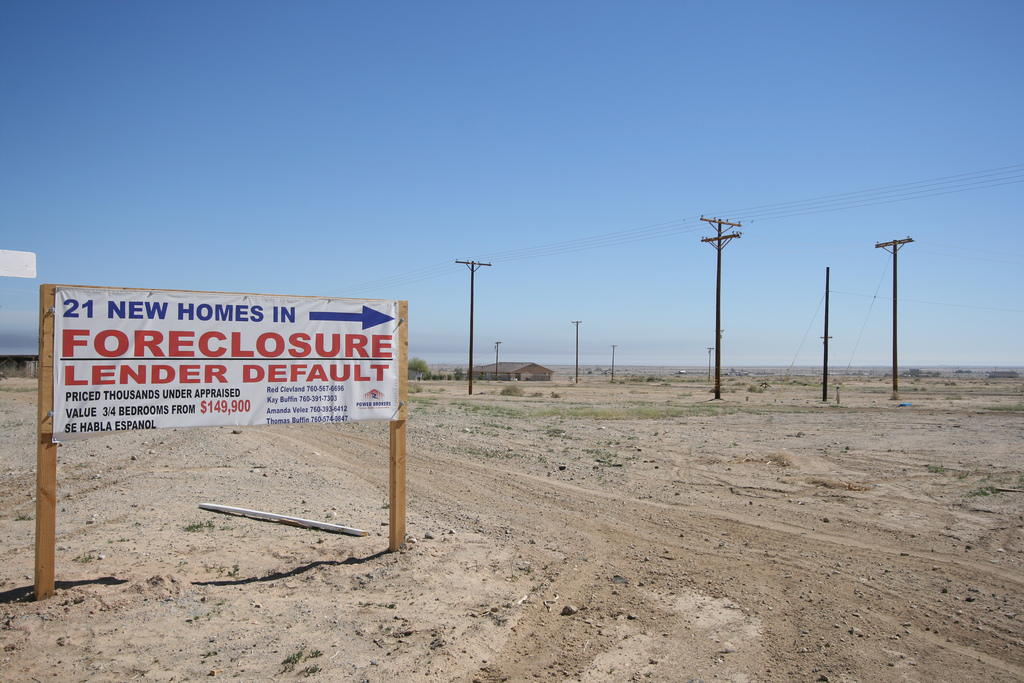Finally, a Bailout for Homeowners?
Treasury and the FDIC put together a plan to offer as many as 3 million homeowners lower loan payments for at least five years. Homeowners, at the center of the economic crisis, may get their turn at a helping hand from government. But can they get the help they really need?
Jul 31, 202017.9K Shares1.1M Views
Foreclosure sign in the Southern California desert (Flickr: jeroen020)
As foreclosures continue at a record pace, homeowners in trouble have watched the government devise a $700-billion rescue plan for Wall Street, buy shares in nine major banks and extend credit to insurance companies like AIG. What they haven’t seen is much of anything coming their way.
Now the Treasury Dept. and the Federal Deposit Insurance Corp. are putting together a plan to offer as many as 3 million homeowners lower loan payments for at least five years. Lenders will be covered for some of their losses should the restructured mortgages go bad. Some details of the $40 to $50 billion plan leaked out this week— and it seems that homeowners at the center of the crisis may finally get their turn at a helping hand from the government.
Illustration by: Matt Mahurin
But, in the end, can they get the help they really need?
The Bush administration isn’t entirely on board with the plan, The Washington Post reported.The White House — which aggressively led the way in pushing for a bailout of the financial system — quickly went on record to say it hadn’t made decisions on any proposals for homeowners.
In contrast to the urgencywith which the administration pushed the bailout package, whatever might be aimed at homeowners apparently will take a while to become a reality.
Even if the plan gets approved, loan modifications haven’t shown themselves yet to be a fully effective curb on foreclosures. To critics, they have been oversold as a way to keep people in their homes, with policy-makers continuing to push them despite any evidence that they really work.
Redoing a loan for someone who still can’t pay it only leaves the borrower worse off than where he started, said Joshua Rosner,managing director of the investment firm Graham Fisher, and a longtime critic of loan modifications. Early in the downturn, failed subprime lender New Century Financialhad loan modification default rates of 50 percent, he said.
Adding to the problem: Restructurings don’t work all that well even in the best of times. Redoing loans while housing prices fall means the homeowner could once again find himself underwater, even with his restructured loan, and in a position to default once again.
Before the government launches mass loan modifications, it should be gathering and analyzing redefault rates, to see if the whole thing is worth it, Rosner said. To him, Congress supports loan modifications as a way to let regulators eke out a patchwork of solutions.
Then it can avoid making a bold but controversial move, like creating something similar to the Home Owners’ Loan Corp., which purchased and refinanced delinquent home mortgages during the Great Depression.
“They’re just trying to declare victory and do nothing,” Rosner said. “We really should be having a public discussion, with facts and figures on loan modifications and redefault rates. Modifying loans in this environment is very risky.”
Others also don’t think the Treasury and FDIC are going far enough. The modification plan simply means they are offering another carrot to entice lenders to restructure loans — but that’s all. It’s a far cry from the unprecedented, sweeping action taken to rescue banks.
The government could direct Fannie Mae and Freddie Mac to undertake mass restructurings, since it controls the two agencies. Housing advocates sayboth continue to foreclose and to refuse to do restructurings on a large scale.
The government could also issue waivers giving securitizers authority to make decisions on restructuring loans, allowing them to bypass the problemof putting back together again mortgage-backed securities that have been sliced into pieces and scattered around the world.
No one’s sure the new government plan will be able to navigate around this roadblock, which has held up many loan modifications. It could mean that only a small percentage of homeowners will get help.
The government could also take an entirely new turn, and back proposals gaining steam lately that would encourage lenders to allow former homeowners to renttheir properties, either for the short- or long-term. Supporting rental policies would keep a property occupied and a homeowner in a home, or would help people who can no longer afford to own their homes find alternatives.
Even with foreclosures jumpingby 71 percent in the third quarter, the government’s latest response to homeowners has fallen far short of any decisive intervention — and that’s a different posture from its moves to prop up the credit markets.
“Clearly, banks are the priority,” said the economist Dean Baker,co-director of the Center for Economic and Policy Research.
In the meantime, it’s been an uphill battle for agencies trying to kickstart loan modifications.
After taking over the failed subprime lender IndyMac in July, the FDIC decidedto try a mass modification of its mortgages, with the goal to setting an industry standard. FDIC Chairwoman Sheila Bair has been an outspoken advocate of mass loan restructurings, and has pushed for more lenders to try them.
But a look at the FDIC numbers that Bair reported last week shows how hard this task is. Of IndyMac’s 60,000 borrowers, 40,000 who were more than 60 days late on their loans were deemed eligible for restructurings.
The FDIC sent out 15,000 letters in the first round of its modification attempt. Of that total, some 3,500 borrowers accepted modification offers, and more are being processed. But it’s still not clear yet how many of them actually will qualify for new loans, spokesman David Barr said.
To financial blogger Tanta at Calculated Risk, the totals provewhat she suspected all along: the FDIC wasn’t going to be any better at loan modifications than the private sector:
“„Certainly 3,500 modifications successfully completed in two months is better than nothing. Then again, I don’t think IndyMac’s modification rate prior to the FDIC takeover was exactly “nothing,” either. Bair doesn’t address that, so we still don’t know if the FDIC’s “expedited” approach has really been measurably better than what IndyMac was already doing. At best, it’s probably only marginally better, which wouldn’t be so much of a problem if Bair hadn’t spent so much time earlier in the year scoring cheap rhetorical points about uncooperative servicers not doing enough to help. In any event, the Bair Plan doesn’t seem likely to bring the mortgage crisis to a screeching halt by year-end.
Not everyone agrees, with some advocates praisingthe FDIC approach as the best way to tackle loan modifications, because one-on-one negotiations are just too lengthy and arbitrary. All loan modifications usually involve lowering the interest rate, reducing the amount of money owed on the loan or stretching out repayments. Borrowers also have to prove they can afford to stay in the home, with the modification.
Under the FDIC approach, borrowers in arrears sign a standard modification agreement that lowers their loan amount. Then they mail in a check for the new payment, along with verifying their incomes.
Barr declined to draw a conclusion from the agency’s progress so far. He said “it’s too early for optimism,” and that the agency’s early results may reflect the easiest and most cooperative borrowers to work with.
To Alan White,a Valparaiso University professor who studies subprime loan modifications, a loan workout is just what it seems — a work in progress. Counselors, agencies and lenders are all getting better at doing them, as they get more experience and as servicers increasingly sign on.
That wasn’t the case at the beginning of the economic crisis. In a sample of a pool of subprime loan modifications begun in 2007, White found not a single loan showing a reduced loan amount, and many loans with higher monthly payments.
Since then, however, some subprime loan modifications have improved, White said. The $700-billion bailout included legal protections for servicers regarding loan modifications, which has helped.
The biggest problem remains that some servicers will restructure loans — and others won’t even try.
Countrywide, for example, does its loan modifications all the same way — by rolling in late payments to the balance and reconfiguring the monthly payment, which usually ends up higher. That’s not a real modification.
“Servicers have been all over the place,” White said. “But what we’re having is a process where things are getting marginally better.”
But that marginal progress is matched by the foreclosure machine’s rapid pace. That means something to stop foreclosures has to be happening at the same time loan modifications are underway, White said. States like Massachusetts, that require some mediation before foreclosure, have had some success in slowing down the process, at least temporarily, he said.
Because servicers don’t make money doing workouts — but do collect fees for foreclosing — a better avenue for Treasury might have been paying servicers $1,500 or so for every loan workout, giving them a financial incentive, White noted. Like Rosner, he also believes modifications have to evaluated for their effectiveness, and targets should be set for new modifications.
Nonetheless, the new approach by Treasury and the FDIC is a step forward, he believes — with a caveat. This is a very positive proposal,” he said. “My concern is that there is such resistance to doing sufficiently aggressive loan restructuring, on the grounds of moral hazard and fairness, that they will produce needlessly stringent guidelines.”
In White’s view, “moral hazard has gotten thrown out the window with the banks” and shouldn’t impede loan restructurings.
Still, unless the government writes some restrictions into its plan, it could create a different kind of moral hazard, said Rosner, the financial analyst. Servicers might rewrite anybody’s loan, whether it would work or not, because they’ll be bailed out by the government in any case. “They could stick it to the homeowner, and to the taxpayer,” Rosner said.
Loan modifications have never been particularly popular with the lending industry. Some believe even government guarantees won’t change that.
Christopher Whalen,an investment banker and research analyst who follows the financial services industry, and who once worked for Bear Stearns, said lenders and servicers aren’t enamored with either workouts or with the idea of becoming rental property managers. If the numbers don’t show someone can afford a house, it’s time to get the foreclosure over with and get that property back on the market, as a first step toward stemming falling home values.
“Lenders are ill-equipped to hold hands with people,” Whalen said. “They don’t want to become a social-services organization. Their goal is to get all this resolved as quickly as possible.”
For people on the brink of losing their homes, the policy debates offer little of anything that’s useful.
Iris Pulliam,51, who lives in Prince Georges County, Md., thought her loan was restructured in July, through the Neighborhood Assistance Corp. of America, a housing advocacy group. But even that group, which attempts mass loan restructurings, hasn’t been able to get her servicer to sign on. She struggles each month to keep up with her payments. “This is very stressful,” she said. “I feel like I’m losing my patience.”
Just like many homeowners, who see everyone else’s hand out for a government bailout, with only theirs coming up empty.

Hajra Shannon
Reviewer
Latest Articles
Popular Articles

